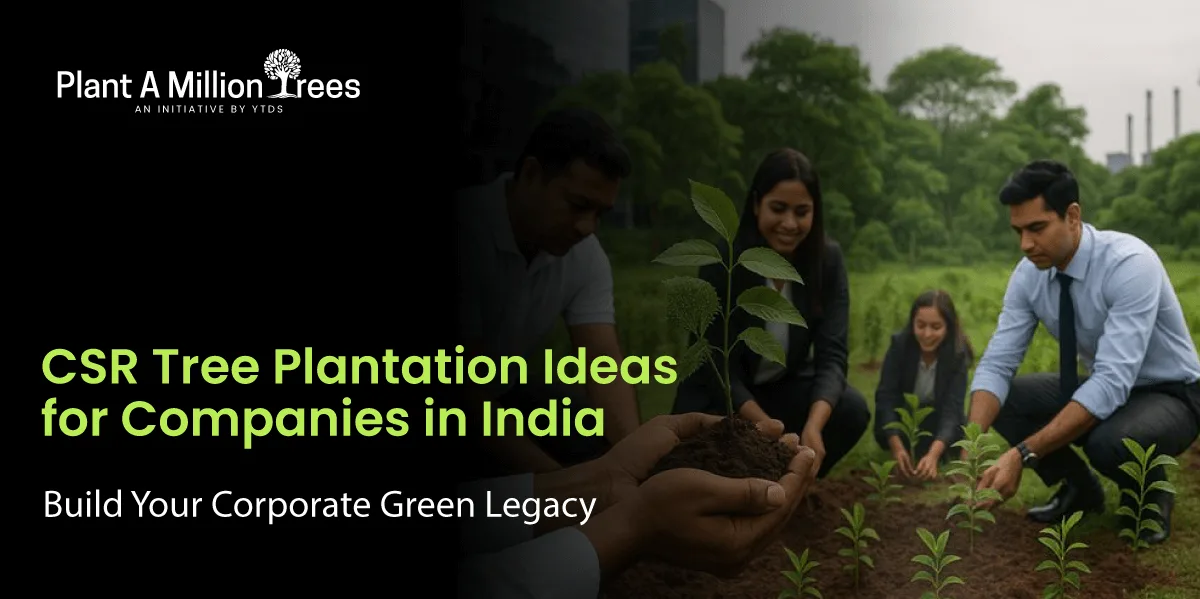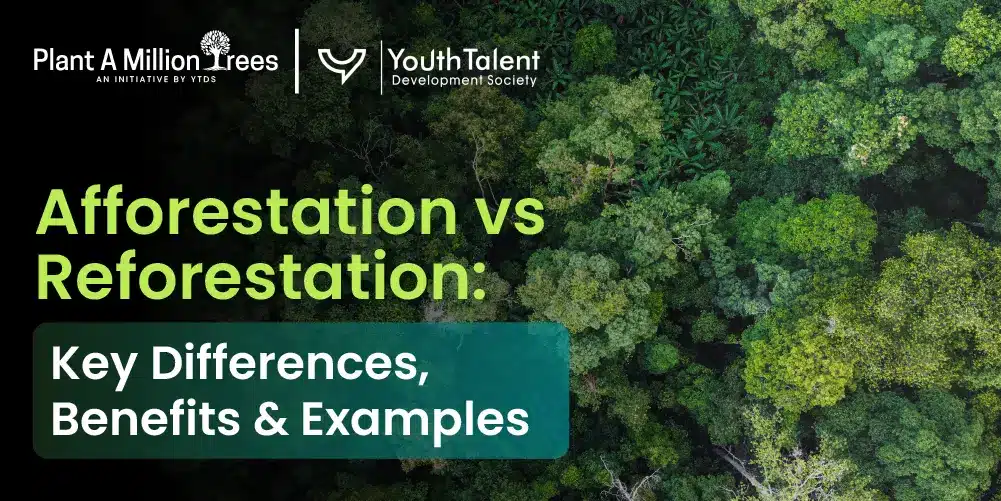Take a stroll through any Indian metropolis nowadays, be it in Delhi, Bengaluru, Chennai or Mumbai, and you will...
India is at a crossroad of corporations. The Corporate Social Responsibility (CSR) is no longer a goodwill thing that companies ought to do as the environmental issues become more relevant and the government in the form of the regulatory bodies strengthens the associated requirements to a measurable and strategic obligation. Out of the numerous environmental CSR concepts that exist in the contemporary world, the idea of CSR plantation in India has turned out to be one of the greatest and most viable practices to companies of all scales. It enhances the green coverage, builds brand equity, promotes climate action, and is directly related to the sustainability objective of India.
This is a comprehensive guide detailing the most appropriate tree plantations to use in the CSR of Indian based companies and assists companies to plan, implement and measure significant green activities. Based on the trends in the industry, examples of successful companies in practice, and the NGO partnership models, this guide aims to assist CSR managers, sustainability heads, HR departments, and corporate foundations implement the tree plantation programs bringing about a tangible, sustainable change.
How Tree Plantation is the best fit in CSR.
One of the most favorites CSR activities is nowadays tree plantation as it intersects with the main pillars of corporate sustainability, community health, and environment renaissance. The modern companies are also measured not only by what they make, but also by the impressions that they make. With the world and country-level ESG (Environmental, Social and Governance) outlines affecting the decision to invest in companies, businesses are instead resorting to green projects that can offer concrete results.
Corresponding to various Sustainable Development Goals (SDGs), CSR tree plantation in India would have the following advantages:
- SDG 13: Climate Action
- SDG 15: Life on Land
- Goal number 11: Sustainable Cities and Communities.
- Goal 17: The Goals of Partnership.
It helps the corporate objectives of carbon neutrality, employee well-being, and brand authenticity also. We should value tall in tree plantation as opposed to short-term charity-driven initiatives; because, long-term tree plantations ensure that communities benefit and also absorb carbon over decades.
Concerned with environmental regeneration has been enhanced by the increased emphasis on corporate social responsibility. Because companies seek to comply with mandatory stipulations, and also align with the expectations of their stakeholders, tree plantation CSR activities are a rather easy to execute, but richly effective one. As the issue of climate grows, this is no longer merely a matter of compliance as CSR tree plantation in India is now being viewed as a way of investing in the future of ecology of the country.
The Reason as to why Tree Plantation is the best CSR Initiative.
Planting trees is distinctly set as the best CSR activity since it provides both tangible and intangible benefits at the same time. It helps in climate resilience in the long-run, provides assistance to the community, and provides measurable environmental results. The current CSR policies prefer those initiatives that present the results, and a tree plantation can provide such measurable results like:
- Reduced CO2 emissions
- Improved air quality
- Restored biodiversity
- More green cover on both the urban and rural locations.
- Soil and water conservation
Moreover, firms will be able to integrate their CSR plan with national policies, such as Panchamrit agreements in India and its efforts to recuperate its eroded lands, so the tree issue will become a robust addition to environmental policies.
Brand building is also becoming centered on environmental CSR concepts like corporate reforestation projects. There is an improvement in the consumption of eco-responsible businesses by consumers and other parties involved. By companies sharing their tree plantation success stories, they will show their adherence to both internal as well as external sustainability objectives.
This congruency, added with the fact that green projects are publicly visible makes the tree plantation as one of the largest and most replicable environmental CSR concepts a company in India would consider.
The Business Pros of Tree Plantation
The positive effects of companies that use CSR to plant trees in India are of extensive scope, including environmental effects. These are some of the advantages that ensure that tree plantation is a good CSR and employee engagement project.
Enhanced Brand Reputation
Customers, investment, and workforce keen on the brands today like brands that do not harm the environment. There is one long-term corporate plantation drive of authenticity and purpose that enhances trust and brand equity.
Engagement and Well-being among the employees.
CSR plantation activities encourage the employees to engage in noble causes. By planting a tree, one can have the sense of ownership and pride. What has been discovered is that green CSR activities can heighten job satisfaction and also stimulate the company culture.
Real ROI with Carbon Offset.
Trees undergo planting which has double-digit implications. As an illustration, businesses may determine carbon offset /100 trees, CO2 absorption cumulatively and environmental enhancement. These indicators are in line with ESG reports, annual sustainability reports, and green audits.
Compliance and Government Alignment.
Planting of trees is in line with national concerns including afforestation, land restoration, and resilience to climate. Such environmental CSR conceptualizations would make companies portray their adherence to the CSR framework in India and provide support to nation-building.
Long-term Community Value
Plantation projects help in the improvement of the soil health, offer shade, decrease pollution, and aid in the biodiversity. When firms commit to sponsoring reforestation exercises within the company, they usually receive great goodwill of the community.
Best CSR Tree Plantation Company Ideas.

The geography and environmental issues in India create various ingenious opportunities to those companies which seek to adopt tree plantation as one of their CSR strategies. The following are some of the innovative and high-impact CSR tree plantation concepts that are in line with the corporate objectives as well as environmental requirements.
Adopt-a-Forest Initiatives
Business entities engage in collaboration with accredited NGOs to reclaim blighted ground through massive plantation farming including the Youth Talent Development Society (YTDS). The forests are cultivated and attended to over several years giving the long term ecological advantage.
Creation of Urban Micro Forest with the Miyawaki process.
The issue of land is limited in urban areas since the Miyawaki approach is among the most appropriate CSR tree planting concepts that Indian firms in cities should consider. These high density urban forests multiply the growth rate 10-fold, and they form hot spots of biodiversity in small areas like corporate campuses, residential townships, and park.
Driven by the employees in Plantations.
The participatory culture of the employees in the tree plantation drives contributes to a high sustainability culture. The businesses are able to arrange the plantation activity on special days like Environment Day, World Earth Day, CSR Day and Foundation Day.
The Rural Reforestation and Soil Restoration Projects.
Businesses have an opportunity to work on recovering the degraded rural territories and protecting the soil health, as well as enhancing the groundwater conditions. Such long-term initiatives tend to benefit the communities of farmers and the local biodiversity.
Highway, River or Lakeside Plantation.
Companies can collaborate with local forest departments to plant local trees on highways, on riverbanks and lakes. Such undertakings safeguard the bodies of water and lower soil erosion.
Corporate Event Tree Gifting.
Formal gifts can also be presented in the form of saplings or planting trees instead of providing the conventional gifts to employees, clients, and other stakeholders. This enhances the green identity of the company.
Office Green Zones
Design green areas, medicinal knots, bamboo corners or fruit-trees areas within the campus. These programs enhance the welfare of employees and lower carbon footprint.
Incentive Drives:
Community-based plantation drives are occurring in regions abundant with local resources.Community-based plantation drives are taking place, where local resources are available.
Companies can enlarge the size of their plantations by engaging villagers, schools and youth groups in generating jobs and awareness.
All these concepts are in line with the practices of sustainable CSR and they assist companies to exercise scalable plantations models that deliver measurable impact.
Indian CSR Plants: Success Stories to be inspired.
Some of the Indian corporations have shown how tree plantation may be incorporated into CSR strategy with far reaching results. These success stories are insightful and inspirational.
TCS Green Drive
There are numerous urban reforestation and rural foresting initiatives by Tata Consultancy Services (TCS) in India. Their forest planting efforts have led to significant CO2 emissions, community empowerment and replenished forest cover.
· Infosys sustainability plantation.
Infosys has directed its attention to the massive reforestation by planting of its campuses with millions of trees. The projects will help the firm achieve its carbon neutrality objectives and enhance its sustainability as a global company.
Mahindra Hariyali Initiative.
Hariyali Mahindra Group has planted trees under the Mahindra Hariyali program and after this program, the Mahindra Group has established forests in various states. The program is a guideline towards the corporate reforestation programs and indicates how a long-term planning limits to the ecological effects nationwide.
As these examples demonstrate, with a solid planning, partnership and execution, CSR tree plantation in India could become one of the pillars of sustainability in a company.
The Process of Collaborating with NGOs and Domestic Bodies.
Tree plantation projects need teamwork to be implemented successfully. Business corporations demand legitimate collaborators, open reporting and quality performance. This is the point where the collaboration with NGOs is necessary.
Significance of qualified NGO Alliances.
A successful CSR relationship with the NGOs secures:
- Plantation methods that are scientific.
- Survival-rate assurance
- Transparent reporting
- Geo-tagging and monitoring
- Post-plantation care
As an example, such organizations as the Youth Talent Development Society (YTDS) focus on data-driven building models of plantations and provide monitoring solutions allowing companies to see their progress.
Plantation Projects Transparency and Monitoring.
The publicity draws a line between good CSR projects and events that are symbolic or are one-time. The NGO partners that the companies ought to select are those that provide:
- Real-time dashboards
- Growth tracking
- Survival-rate metrics
- Third-party verification
- Community Involvement Report.
Such revelations will generate trust and enable businesses to uphold high qualifications on their corporate social responsibility planning.
Actions to Implement a Tree Plantation CSR Project
The plantation project cannot be planned and executed without some structure. This is a step-by-step guide that can assist the companies to have effective plantations.
Step 1: Accept Goals and Scope
Establish the purpose carbon offset, community development, creation of green belt or enhancement of biodiversity. Establish quantifiable goals in terms of quantity of trees, type of species and impact measures.
Step 2: Select an Appropriate Meeting place.
Collaborate with NGOs or local government to find areas in demand- urban areas, rural areas that have been degraded, school grounds, campuses, industrial belts or riverbanks.
Step 3: Select Native Species
Native structures guarantee balances and survival. They need fewer menials and take advantage of the existence of the local biodiversity.
Step 4: Implement finds Scientific Plantation
Plantation process should be under scientific standards such as preparation of the soil, the size of the pits, mixing of organic composts, mulching, irrigation, and proper spacing.
Step 5: Monitoring after plantation growth
- Monitoring is essential. Projects must include:
- Watering cycles
- Mulching
- Saplings Dead saplings should be replaced.
- Geo tags and developments.
- Opportunities in employee volunteering.
This would see the plantation turn into a self-sustaining forest.
Step 6: Reporting/ Documentation
CSR reports should include:
- Plantation site details
- Species list
- Before and after plantation shots.
- The estimation of carbon sequestration.
- Involvement measures of the community.
These reports play a significant role in compliance, stakeholder reporting as well as ESG reporting.
Conclusion
CSR Tree planting in India is not just a box to be checked in a compliance list but is a strategic, ethical and long term contribution to the environment and the society. The increasing rate of global warming will compel firms to generate powerful environmental CSR concepts that have long-term impressions. Planting trees still remains a heavy-handed and efficient solution.
Businesses that consider the most optimal plans of tree planting to the Indian companies are the ones that do not just improve the sustainability footprint of the business, but they also give the communities, employees and other stakeholders the desire to be part of the greener part of the future. When properly planned, collaborated and monitored like in the case of the collaboration with companies such as the Youth Talent Development Society, corporations can establish successful ecosystems, revitalize damaged land, and create significant climate programming.
Corporate reforestation projects will continue to be key pillars of environmental responsibility as India continues to grow to be a sustainable system. Investing companies today will leave behind a positive legacy of impact to shape a greener healthier tomorrow.




